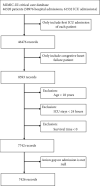Serum Anion Gap Is Associated with All-Cause Mortality among Critically Ill Patients with Congestive Heart Failure
- PMID: 33282007
- PMCID: PMC7688352
- DOI: 10.1155/2020/8833637
Serum Anion Gap Is Associated with All-Cause Mortality among Critically Ill Patients with Congestive Heart Failure
Abstract
Background: Congestive heart failure (CHF) is a complex clinical syndrome, with high morbidity and mortality. Serum anion gap (SAG) is associated with the severity of various cardiovascular diseases. However, the role of SAG indicators in CHF is unclear.
Methods and results: A retrospective analysis of data from Multiparameter Intelligent Monitoring in Intensive Care III version 1.4 was conducted in critically ill patients with CHF. The clinical information of each patient, including demographic data, comorbidities, vital signs, scores, and laboratory indicators, were successfully obtained. Cox proportional hazards models were used to determine the relationship between SAG and mortality in patients with CHF, the consistency of which was further verified by subgroup analysis.
Results: A total of 7426 subjects met the inclusion criteria. Multivariate analysis showed that after adjusting for age, gender, ethnicity, and other potential confounders, increased SAG was significantly related to an increase in 30- and 90-day all-cause mortalities of critically ill patients with CHF compared with decreased SAG (tertile 3 versus tertile 1: adjusted hazard ratio, 95% confidence interval: 1.74, 1.46-2.08; 1.53, 1.32-1.77). Subgroup analysis indicated that the association between SAG and all-cause mortality presented similarities in most strata.
Conclusion: SAG at admission could be a promising predictor of all-cause mortality in critically ill patients with CHF.
Copyright © 2020 Yiyang Tang et al.
Conflict of interest statement
All authors declare that there is no conflict of interest.
Figures



References
MeSH terms
Substances
LinkOut - more resources
Full Text Sources
Medical
Miscellaneous

